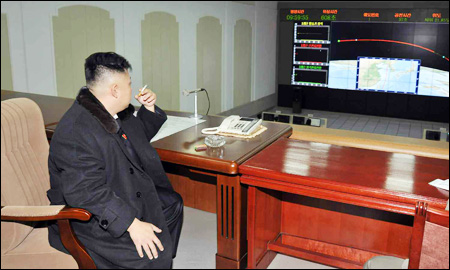Plan to punish NK comes into focus

North Korean leader Kim Jong-un smokes a cigarette while waiting for the launch of an Unha-3 long-range rocket Wednesday at the General Satellite Command and Control Center in Pyongyang in this photograph released by the North’s Korean Central News Agency. (Photo : Yonhap)
South Korea’s blueprint for penalizing North Korea for its provocative rocket launch took shape Friday, involving the reinforcement of existing sanctions and the addition of new punitive measures.
Officials said Seoul was on the same page with Washington and Japan over a shared approach involving desired measures at the U.N. Security Council (UNSC), as well as a multilateral campaign similar to that used on Iran by the U.S. administration.
The 15-member council has been deliberating since shortly after the Wednesday launch, which was widely seen as a test of ballistic missile technology.
The three countries want to bolster existing sanctions, including changing non-mandatory aspects of UNSC Resolution 1874, implemented after Pyongyang’s nuclear test in 2009, into compulsory ones.
This could involve making compulsory aspects of the resolution that “calls on” states not to provide financial assistance if it could contribute to proliferation, and conduct inspections on their territory when there are “reasonable grounds” that banned cargo is on a ship.
They also want to expand the number of North Korean individuals and entities sanctioned for violating resolutions. After Pyongyang’s failed launch in April, Washington proposed some 40 such entities, but China, a permanent member of the council vetoed all but three.
Beijing, undergoing a leadership transition to Xi Jinping, immediately protested the launch. But many analysts believe it will maintain a status quo approach to the peninsula, fearing instability on its borders that could hamper its economy.
While condemning the launch, China, the North’s ally, has called for the U.N. response to be “prudent, appropriate and conducive to peace and stability on the Korean peninsula.”
Seoul and Washington also appeared to be on the same page about targeting remaining international bank accounts used by the North.
Meanwhile, details continued to emerge about the launch as the Navy retrieved debris from the first stage of the rocket in the West Sea.
A joint investigation team of military and civilian experts, including some from the United States, will examine the debris, the defense ministry said. This may offer insight into the technology that allowed Pyongyang to successfully launch the rocket.
The debris, believed to be part of a fuel container, was retrieved shortly after midnight Friday by a Deep Submergence rescue vehicle and transported to Pyeongtaek Port.
The defense ministry said the object, detected shortly after the launch in waters some 160 kilometers west of Gunsan, Jeolla Province, is inscribed with the name of the rocket, “Unha” and is 7.6 meters long with a diameter of 2.4 meters.
It will be examined by officials from the defense ministry, the Joint Chiefs of Staff and the Agency for Defense Development.
“It is expected to become useful material for analysis of North Korea’s rocket technology,” defense ministry spokesman Kim Min-seok said.
The launch has upped the stakes over Pyongyang’s nuclear weapons program, as analysts say it represents a step forward in the North’s coveted goal of long-range missile technology. <The Korea Times/Kim Young-jin>





















































